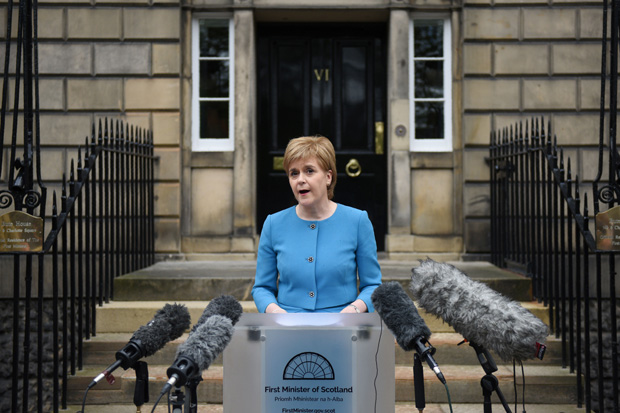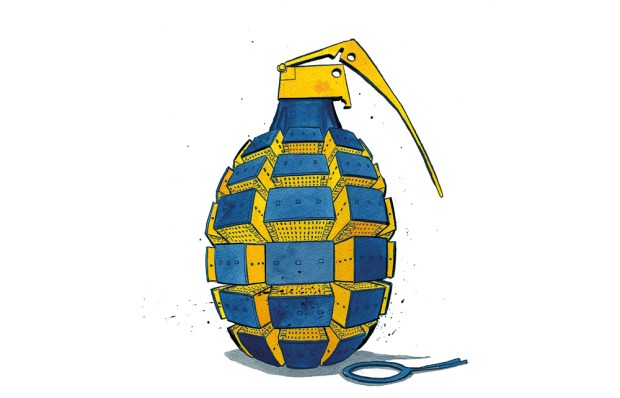There is no party in Britain quite as fake as the Scottish National Party. The SNP, now entrenched in its dominance of Scottish politics, imagines itself a revolutionary force for change. Its mission to break up Britain bolsters that impression. But if the SNP campaigns with zeal, it governs with caution. These are the most conservative revolutionaries on the planet.
On health, education and taxes, the SNP stresses continuity. The party saves its radicalism for issues the public considers trivial. One is Trident. Another is land reform.
According to an opinion poll earlier this year, just 3 per cent of voters consider nuclear weapons one of the three most important issues facing Scotland. Just 2 per cent think that of land reform. Yet the SNP pledges to bring about a nuclear-free country with a transformed pattern of land ownership.
On land reform, ministers now enjoy the power to force a sale ‘where the scale or decisions of landowners are acting as a barrier to the sustainable development of communities’. How that is to be defined remains a mystery.
Still, land distribution is an atavistic problem and one that allows for any amount of demagoguery. As Mike Russell, SNP MSP for Argyll and Bute, says, a landowner is ‘able to do whatever he likes on his property’. This is intolerable.
The SNP’s proposals might be more ‘radical’ but for the constraints of the European Convention on Human Rights. There is an irony in the fact that the SNP, a staunch opponent of Conservative proposals to withdraw from the convention, finds its hands partially bound by the system it defends in other circumstances. This too is intolerable or, as Russell argues, the convention ‘was never meant to be a tool to protect the rich against the poor’. Perhaps not, though it may have been a tool to ensure equal protection under the law for all.
Writing in The Spectator last year, William Astor, David Cameron’s father-in-law, who owns the Tarbert estate on the Isle of Jura, worried about a ‘Mugabe-style land grab’ in which estate owners might be ‘nationalised’ or ‘made to feel so unwelcome that we have to sell up’. A senior figure within Scottish Land and Estates, the landowners’ representative body, observed that these remarks were ‘distinctly unhelpful’. It was suggested Viscount Astor might henceforth observe a period of silence on the matter.
The fact that half of Scotland’s land is owned by just 432 people remains a psychological affront to many Scotsmen. The sense that the Highlands are little more than a rich man’s playground, to be visited for a few weeks’ shooting and fishing each year, remains keenly felt. Radical campaigners for independence point to the empty hills and condemn them as the price of Union, conjuring an imagined future in which the lairds will be routed and the glens repopulated with smallholders and cottage industries. Like so much that is written about the Highlands, this is a fantasy, albeit a beguiling one.
Landowners point to the value of their contributions to the rural economy — and the jobs maintained in managing their estates — but their greatest weakness is their absenteeism. This causes resentment, though not always from the people who actually live on their estates.
The idea of community ownership is attractive. What could be better, and fairer, than land being owned by the people who live on it? But the experience of estates purchased by the ‘community’ demonstrates that someone, somewhere, always has to pay.
Frequently it’s the lowland public, who already (and rightly) help subsidise the Highlands and Islands, who are asked to sustain far-flung and fragile communities. Without generous grants and subsidies, many of the estates now managed by local communities would, like many of their privately owned neighbours, be unprofitable concerns. A new report compiled by Anthony Torrance, a land management expert, reveals that six high-profile community buyouts have received ‘covert subsidies’ of more than £5 million over the past five years.
The state, via public funding or quasi–public lottery investment, has replaced landlords as the guarantor of community viability. The Isle of Gigha Heritage Trust, for instance, lost £269,000 in 2014 and would be in even more trouble if it weren’t for the guaranteed prices supporting renewable energy schemes. The withdrawal of subsidy for new onshore wind farms inevitably imperils the viability of future community buyouts.
In the past 20 years more than £20 million of public money has been spent subsidising community buyouts, and the government promises to support the purchase of another 500,000 acres by 2020. Some of these have been successful. On the Knoydart peninsula, for instance, the population has doubled since the estate was bought by the community in 1999. A buyout on South Uist in 2006 has also helped revitalise the island, not least thanks to the proceeds from wind farms and the regeneration of the harbour at Lochboisdale.
At heart, the argument is over the extent to which the state should interfere in land ownership and the extent to which taxpayers in other parts of Scotland should subside community ownership of land in the Highlands and Islands. According to Roseanna Cunningham, the minister responsible, ‘Land reform is at the heart of this government’s ambitions for a fairer and more prosperous Scotland.’
Even so, campaigners worry that ministers will shy away from more radical reform. As A.J.P. Taylor put it, ‘There is nothing more agreeable in life than to make peace with the establishment — and nothing more corrupting.’ When it comes to land reform, one side’s satisfaction is suspicious. If Scottish Land and Estates are, on the whole, ‘comfortable’ with the government’s latest land bill, that bill will be considered disagreeably feeble.
Which is also why land reform remains, in the words of one prominent campaigner, ‘unfinished business’. It is the means by which the SNP, now a party of government, maintains its faith in its old radical religion.
The post Highland sting appeared first on The Spectator.
Got something to add? Join the discussion and comment below.
Get 10 issues for just $10
Subscribe to The Spectator Australia today for the next 10 magazine issues, plus full online access, for just $10.
You might disagree with half of it, but you’ll enjoy reading all of it. Try your first month for free, then just $2 a week for the remainder of your first year.















Comments
Don't miss out
Join the conversation with other Spectator Australia readers. Subscribe to leave a comment.
SUBSCRIBEAlready a subscriber? Log in